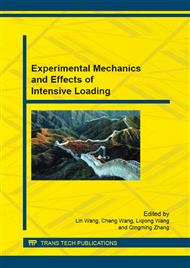p.219
p.227
p.237
p.245
p.252
p.261
p.271
p.278
p.291
Analyzing Stress Wave Propagation in a Hollow Bar Loaded Three-Point Bend Fracture Test Using Numerical Methods
Abstract:
Modified Hopkinson pressure bar apparatus is widely used to investigate the dynamic fracture behavior of materials at higher rate loading. While using a small sample for fracture toughness testing, plane strain conditions are compromised. In the current work, a large diameter two-bar/ three-point bend fracture setup is used to analyze stress wave propagation behavior within a larger cracked specimen. The experimental setup model consists of striker, incident bar, loading pin, cracked three-point specimen, span and transmission bar. The model is prepared using ANSYS software and the transient dynamic analysis technique is used to simulate the dynamic load. The effects of increased transient time on the stress wave propagation behavior within the cracked sample and the stress and strain values at the crack tip of the three-point bend specimen are analyzed. In addition, the effects of the hollow striker, the hollow incident bar and the specimen span are studied. It is found that during large specimen testing, an increase in the transient time results in the lower stress and strain values in the specimen crack-tip. The relationship of the specimen span, the striker and the incident bars with the strain values in the specimen is analyzed and a method for the three-point bend specimen testing at the higher strain rates is also proposed.
Info:
Periodical:
Pages:
252-260
Citation:
Online since:
August 2015
Authors:
Price:
Сopyright:
© 2015 Trans Tech Publications Ltd. All Rights Reserved
Share:
Citation:


